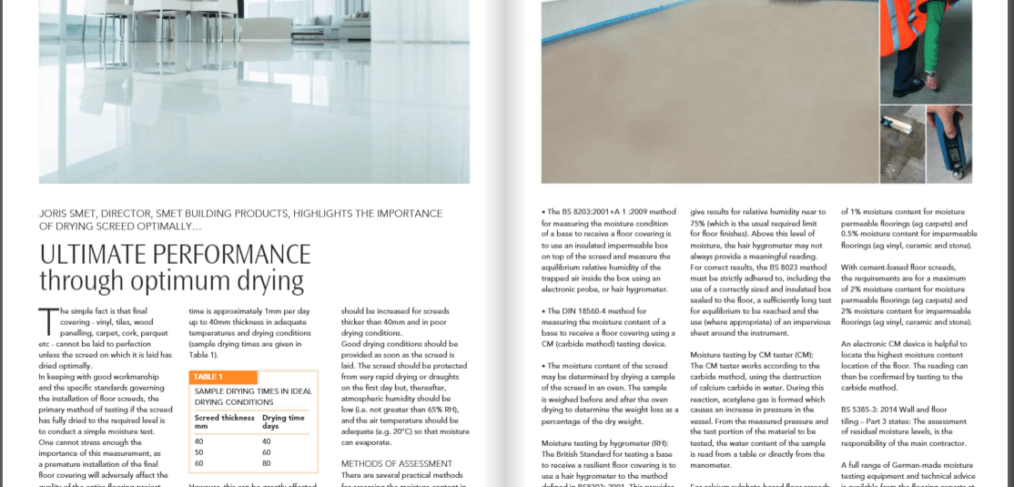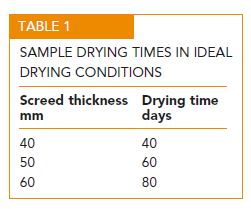
The Ultimate in Screed Performance – through optimum drying
ULTIMATE SCREED PERFORMANCE – through optimum drying
JORIS SMET, DIRECTOR of SMET BUILDING PRODUCTS, HIGHLIGHTS THE EXTREME IMPORTANCE OF DRYING SCREED PROPERLY BEFORE COVERING…
For all the details read further in Northern Builder
The simple fact is that final covering – vinyl, tiles, wood panelling, carpet, cork, parquet etc – cannot be laid to perfection unless the screed on which it is laid has dried optimally. In keeping with good workmanship and the specific standards governing the installation of floor screeds, the primary method of testing if the screed has fully dried to the required level is to conduct a simple moisture test. One cannot stress enough the importance of this measurement, as a premature installation of the final floor covering will adversely affect the quality of the entire flooring project.
Per BS 5385-3:2014, screed drying time is approximately 1mm per day up to 40mm thickness in adequate temperatures and drying conditions (sample drying times are given in Table 1).
However, this can be greatly affected by actual conditions. This period should be increased for screeds thicker than 40mm and in poor drying conditions.
Good drying conditions should be provided as soon as the screed is laid. The screed should be protected from very rapid drying or draughts on the first day but, thereafter, atmospheric humidity should be low (i.e. not greater than 65% RH), and the air temperature should be adequate (e.g. 20°C) so that moisture
can evaporate.
METHODS OF ASSESSMENT
There are several practical methods for assessing the moisture content in screeds
• The BS 8203:2001+A 1:2009 method for measuring the moisture condition of a base to receive a floor covering is to use an insulated impermeable box on top of the screed and measure the equilibrium relative humidity of the trapped air inside the box using an electronic probe, or hair hygrometer.
• The DIN 18560-4 method for measuring the moisture content of a base to receive a floor covering using a CM (carbide method) testing device.
• The moisture content of the screed may be determined by drying a sample of the screed in an oven. The sample is weighed before and after the oven-drying to determine the weight loss as a percentage of the dry weight.
Moisture testing by hygrometer (RH): The British Standard for testing a base to receive a resilient floor covering is to use a hair hygrometer to the method defined in BS8203: 2001. This provides a nondestructive test method and will give results for relative humidity near to 75% (which is the usually required limit
for floor finishes). Above this level of moisture, the hair hygrometer may not always provide a meaningful reading.
For correct results, the BS 8023 method must be strictly adhered to, including the use of a correctly sized and insulated box sealed to the floor, a sufficiently long test for equilibrium to be reached and the use (where appropriate) of an impervious sheet around the instrument.
Moisture testing by CM tester (CM): The CM tester works according to the carbide method, using the destruction of calcium carbide in water. During this reaction, acetylene gas is formed which causes an increase in pressure in the vessel. From the measured pressure and the test portion of the material to be tested, the water content of the sample is read from a table or directly from the manometer.
For calcium sulphate-based floor screeds, the requirements are for a maximum of 1% moisture content for moisture permeable floorings (eg carpets) and 0.5% moisture content for impermeable floorings (eg vinyl, ceramic and stone).
With cement-based floor screeds, the requirements are for a maximum of 2% moisture content for moisture permeable floorings (eg carpets) and 2% moisture content for impermeable floorings (eg vinyl, ceramic and stone).
An electronic CM device is helpful to locate the highest moisture content location of the floor. The reading can then be confirmed by testing to the carbide method. BS 5385-3: 2014 Wall and floor tiling – Part 3 states: The assessment of residual moisture levels is the responsibility of the main contractor.
A full range of German-made moisture testing equipment and technical advice is available from the flooring experts at SMET.
https://www.smetbuildingproducts.com/products/floor-screeds/
sales@smetbuildingproduct.com

